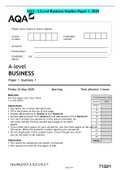Resume
Complete and Detailed Summary: Motivation and Performance (SOW-PSB2SP50E)
- Cours
- Établissement
This is a detailed and fully complete summary of the lectures from the course Motivation and Performance (SOW-PSB2SP50E) at Radboud University. It is all you need to successfully complete the class and pass the exam with a good grade. I have put a lot of effort into writing the summary, adding my ...
[Montrer plus]












